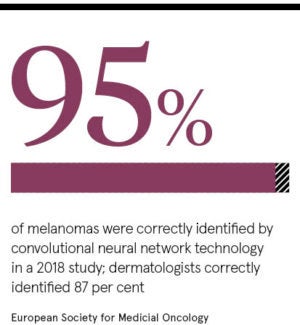As any dermatologist, or regular pub quizzer, will be able to tell you, skin is the largest organ of the human body, which brings with it some scaled-up problems for those involved in the specialism. Thankfully, innovative dermatology is enabling practitioners to diagnose and treat skin diseases better and more effectively than ever before, and the latest in skincare technology is helping to solve some of the biggest challenges facing this diverse practice.
With new cases of melanoma skin cancer averaging almost 16,000 between 2014 and 2016 in the UK, one of the most sizeable of these challenges is early detection and diagnosis. However, thanks to it being an acutely visual specialty, dermatologists may soon be able to rely on a particular form of deep-thinking second opinion in the form of artificial intelligence (AI).
We envisage that sooner than later automated diagnosis will change the diagnostic paradigm in dermatology
 This was first identified in 2017 after watershed research from Stanford University found that a form of AI known as a convolutional neural network (CNN) could do a better job of distinguishing between a benign mole and a malignant melanoma than a panel of dermatologists.
This was first identified in 2017 after watershed research from Stanford University found that a form of AI known as a convolutional neural network (CNN) could do a better job of distinguishing between a benign mole and a malignant melanoma than a panel of dermatologists.
“CNN is an algorithm, which is able to focus on different properties in an image and pull out the things that are relevant and important,” explains Dr Karen Panetta, an expert in AI in healthcare. “CNN pushes the evolution of AI even further and is a very exciting tool to leverage in the search for more accurate dermatological diagnosis.”
The merit of AI’s real-world application in dermatology was further confirmed last year with another study published by the European Society for Medical Oncology (ESMO), which found that CNN, once again, outperformed dermatologists in identifying melanomas from a sample of 100 images, correctly identifying 95 per cent compared with 87 per cent by qualified dermatologists.
Advancing diagnostic accuracy
The goal of all this research is not to pit dermatologists against the latest in skincare technology, but to fine-tune AI into a technological tool at the disposal of the profession.
“Most dermatologists already use digital dermoscopy systems to image and store lesions for documentation and follow-up,” says Professor Holger Haenssle, who led the ESMO study. “The CNN can then easily and rapidly evaluate the stored image for an ‘expert opinion’ on the probability of melanoma.”
Professor Haenssle, who is currently planning prospective studies to assess the real-life impact of CNN, says: “Currently, there is no substitute for a thorough clinical examination. However, 2D and 3D total body photography is able to capture about 90 to 95 per cent of the skin surface and, given exponential development of imaging technology, we envisage that sooner than later automated diagnosis will change the diagnostic paradigm in dermatology.”
AI is a clear example of how the latest in skincare technology can be used to improve patient care and Professor Haenssle can speak with such confidence about the timescale of the change because of AI’s ability to teach itself through machine-learning, where CNN continually improves its performance with every additional image it sees.
An end to skin tissue shortages
Of course, AI isn’t the only high-tech solution to current dermatological problems as it’s also hoped that the latest in skincare technology can help to reduce the shortfall in donor tissue, which has recently plagued countries such as Australia and Japan.
Advances in 3D bioprinting mean that it’s now possible to create totally functional synthetic skin at the touch of a button, and a research partnership between scientists at the Charles III University of Madrid and bioengineering firm BioDan Group has already produced a pioneering prototype. Rather than using cartridges and inks, the printer layers bioinks over one another on a print bed to replicate the natural structure of skin, from epidermis to dermis.
This kind of bioprinting isn’t limited to the lab, as researchers from the US Wake Forest School of Medicine have shown by producing a mobile printer that can deliver skin directly on to a patient’s body, offering a realistic alternative to skin grafts when the availability of healthy tissue is low. The process begins by taking a biopsy of tissue and extracting healthy cells, which are then mixed into a hydrogel to be fed through the print heads. Software directs the print heads to topically deliver the cells, building it up layer by layer until the structure is complete.
It’s thought this particular form of bioprinting could be especially relevant to real-world wound treatments as doctors would be delivering the patient’s own cells to the area, speeding up the healing process.
The future of melanoma treatment
Nanotechnology is another exciting area for physicians as the properties of sun creams and anti-ageing products are engineered into nano-sized particles, increasing their bioavailability by making them more easily absorbed by the skin.
In anti-ageing products, nanomaterials represent the latest in skincare technology because they allow active ingredients, such as vitamin C, which would not normally penetrate the skin, to be delivered through it and increase rejuvenation. There is even potential for nanotechnology to be used in melanoma treatment with the discovery that gold can be turned into a nanoparticle and combined with a molecule that hones in on cancerous tissue. When a specific wavelength of light is targeted at the tissue, the gold nanoparticles heat up and kill the surrounding tumour, leaving the surrounding tissue unaffected.
It’s another demonstration of why dermatology is considered one of the prime areas for technological health intervention and, thanks to a number of exciting advances in innovative dermatology, it’s clear there is already plenty of skin in the game.

